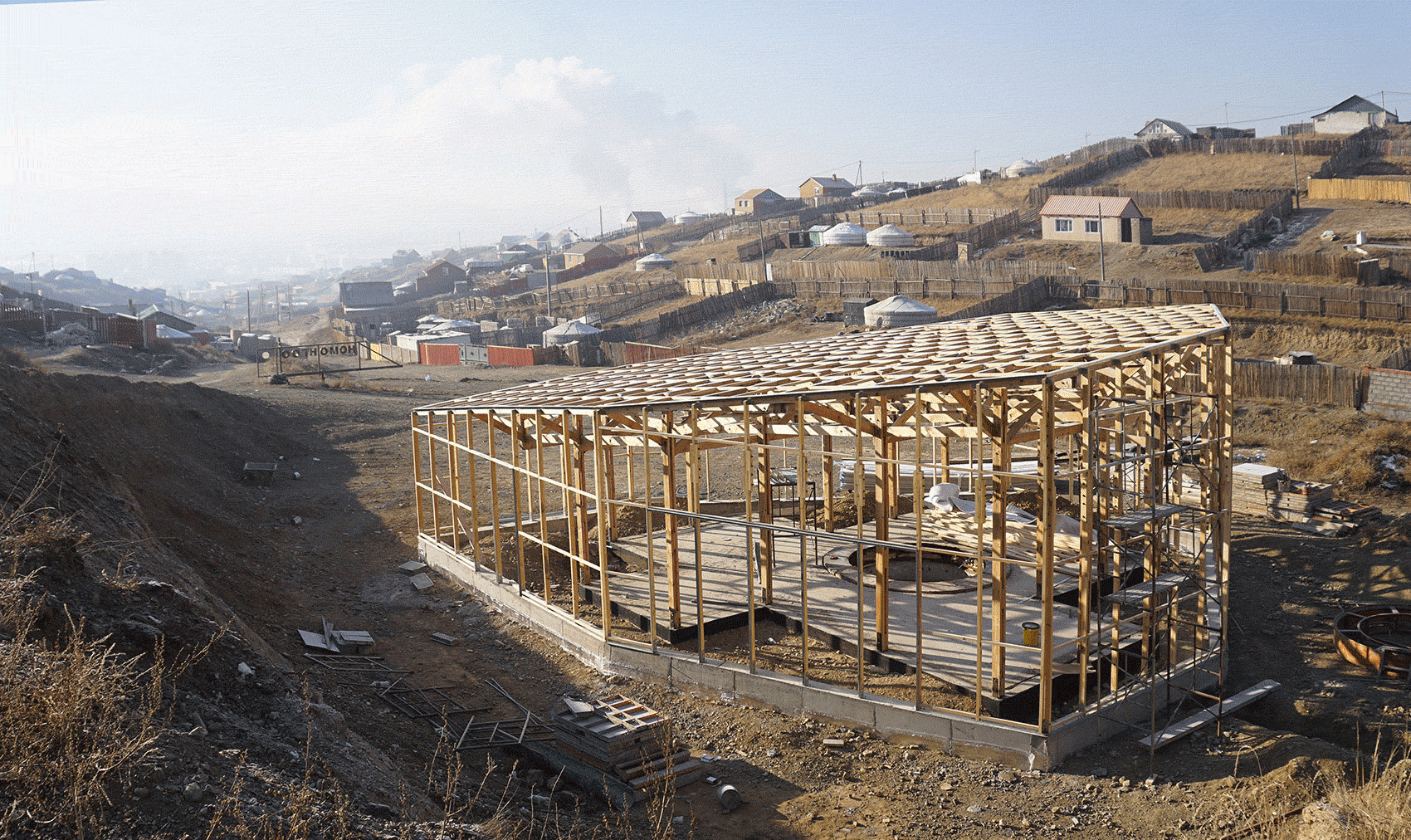查看完整案例


收藏

下载
蒙古包区创新中心为居住在蒙古乌兰巴托蒙古包区的居民提供了急需的社区基础设施。这些地区没有自来水或污水处理系统,在温度达到-40°C 的严寒冬季,煤炭是主要的热能来源,这导致空气污染的问题急剧恶化。该市超过 70%的人口居住在这些定居点,这些定居点更以每年 30,000 人的速度增长,其中许多人放弃了游牧的生活方式而迁移到城市居住。在城市化的过程中,由于居民面临著新的挑战并遇到了共同的问题,这些问题因此成为人们集体的责任。在没有“社区”一词的文化中,这项目的目的是使居民能够找出共同生活的意义,并寻求新的合作方式。
▼项目外观,external view of the project ©城村架构 (RUF)
The Ger Innovation Hub provides much needed community infrastructure to residents living in the Ger districts of Ulaanbaatar, Mongolia. These districts have no running water or sewage systems and in the extreme winter, with temperatures reaching -40 °C, coal is the main source of heat, resulting in debilitating air pollution. Over 70% of the city’s population live in these settlements which are growing by 30,000 people per year, many of whom give up a nomadic lifestyle to move to the city. In the process of becoming urban, residents are confronted with new sets of challenges and they encounter common problems that become the responsibility of a collective body of people. In a culture which has no word for “community”, the aim of the project is to enable residents to address what it means to live together and forge new methods of collaboration.
远景,项目位于蒙古包区,distanced view of the project located in the Ger district ©城村架构 (RUF)
这社区中心提供托儿所、课后俱乐部、表演空间以及用于演讲和职业培训的教育讲习班。我们因蒙古包启发,设计了一种分层结构:由泥砖製成的内部空间被聚碳酸酯的外层包围,形成了一个缓衝空间可以在冬季探集辐射热。这减少了能源消耗,并成为该地区减少煤炭使用的典范。
The Hub will offer a crèche, after-school club, performance space and educational workshops for talks and vocational training.
Inspired by the ger, we designed a layered structure: An inner room made of mud bricks is surrounded by an outer layer of polycarbonate, creating a buffer space that traps radiant heat in the winter. This reduces energy consumption and serves as a model for the district to reduce coal use.
项目采用木质结构,外层包裹聚碳酸酯,wooden structure with an outer layer of polycarbonate ©城村架构 (RUF)
▼冬季外景,项目可以适应寒冷的气候,external view of the project in the winter ©城村架构 (RUF)
▼温度分析,建筑的结构可以减少能源消耗,temperature analysis, the structure of the project could help reduce energy consumption ©城村架构 (RUF)
▼室内外层走道,corridor in the outer space of the project ©城村架构 (RUF)
▼泥砖制成的内部空间,inner space made of mud bricks ©城村架构 (RUF)
这建筑物在社区中成为了一个属于所有阶层的地方,特别是在冬季,当居民仅局限于家属间之活动时,它提供了多一个可供选择的去处。于我们继续监测和评估建筑物的性能时,这项目亦示范了如何将建筑过程成为支持社区建设的新模式。
The building is a place for all sections of the community and offers an alternative place to go, when, particularly in winter, residents are confined to their households. As we continue to monitor and evaluate the building’s performance, the project demonstrates how the process of making architecture can be a model to enable the construction of a community.
▼室内活动,加强社区建设,activities in the building, enhancing the construction of the community ©城村架构 (RUF)
▼建造过程,construction process ©城村架构 (RUF)
▼总平面图,master plan ©城村架构 (RUF)
▼平面图,plan ©城村架构 (RUF)
▼剖透视图,perspective section ©城村架构 (RUF)
位置:蒙古乌兰巴托 Songino Khairkhan 43
设计:Joshua Bolchover , 林君翰 (城村架构,香港大学)项目领导:潘豫芯
项目团队: Chiara Oggioni
项目合作伙伴:GerHub: Badruun Gardi and Enkhjin Batjargal, Ecotown NGO: Odgerel Gansukh
承包商:Odgerel Gansukh
木材供应商:Shinest Co. Ltd
环境顾问:Chad Mckee
项目开始:2018 一月
施工:2018 六月至 2020 一月
评估:进行中
总计花费: $67,500 美元
单位价: $420 美元 / 平方米
总面积: 160平方米
室内面积: 73平方米
基金:香港赛马会慈善信託基金 (属于赛马会港大城村设计项目)YPO ASEAN United.
支持机构:香港大学,香港大学专业进修学院
图片来源:城村架构 (RUF)
Location: Songino Khairkhan 43, Ulaanbaatar, Mongolia
Design: Joshua Bolchover and John Lin (Rural Urban Framework, The University of Hong Kong)Project Leader: Jersey Poon
Project Team: Chiara Oggioni
Project Partner: GerHub: Badruun Gardi and Enkhjin Batjargal, Ecotown NGO: Odgerel Gansukh
Contractor: Odgerel Gansukh
Wood supplier: Shinest Co. Ltd
Environmental Consultant: Chad Mckee
Project start: January 2018
Construction: June 2018-January 2020
Evaluation: ongoing
Total cost: $67,500 USD
Unit cost: $420 USD/m2
Total area: 160m2
Inner area: 73m2
Funding: Hong Kong Jockey Club Charities Trust (as part of the Jockey Club HKU Rural-Urban Design Project), YPO ASEAN United.
Supporting Institutions: The University of Hong Kong, HKU School of Professional and Continuing Education
IMAGE CREDITS: Rural Urban Framework (RUF)

































